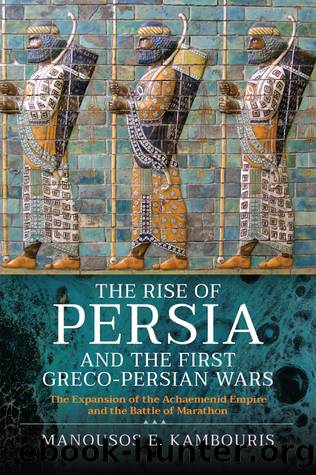The Rise of Persia and the First Greco-Persian Wars by Manousos E Kambouris;

Author:Manousos E Kambouris; [Kambouris;, Manousos E]
Language: eng
Format: epub
Tags: History / Military / Ancient
ISBN: 9781399093293
Publisher: Casemate
Published: 2022-05-30T00:00:00+00:00
Cyprus: a decisive sideshow
The revolt of Cyprus must have taken place before the battle of Ephesus (Her V. 108). Instigated by Onesilus of Salamis, younger brother of the steadily pro-Persian King Gorgus whom he deposed without exterminating (Her V.104,2) â a common but lethal mistake of the insurgents (Her V.38,1 & VI.9,2â3), it spread throughout the island. Salamis was situated at the heart of the eastern bay of Cyprus, and the rebellion was countered by the Phoenician cities of the south/southeast, Amathous reportedly (Her V.104,3) and Kition probably (Burn 1962). The imperial force tasked to suppress it was mustered under Artybius at Cilicia and crossed to Cyprus on Phoenician vessels (Her V.108), most probably by landing to Kerynia at the northern side of the island, to outmanoeuvre the Ionian fleet sent for assistance (Her V.108,2). The latter was probably patrolling off Salamis, the epicentre of the revolt of Cyprus, as was the case with Ionia, where the fleet was assembling at Miletus. As a result, the Persian army had to cross the mountain range of Pentadaktylos to approach Salamis and make contact or relieve Amathous (Burn 1962).
The satrapy of Phoenicia must have contributed vessels, marines and crews but not land forces; still, Persian troops stationed there might have been mobilized and participated. The forces of Cilicia, Persian and native, must have been the backbone, under Artybius, who must have been the general of the satrapy, as Cilicia was self-governed by the local Syennesis line of rulers (Her V.118,2). It should be noted that Behistun does not mention Cilicia as a satrapy; nor Phoenicia; the latter must have been included either in Arabia or, less probably, in Assyria. It is not very clear which timeframe of the Persian state is commemorated in the list of Behistun, but 23 lands are mentioned while Herodotus mentions 20 satrapies returning taxes plus Persis, and Xerxesâ army included 29 commands based on territorial muster and conscription.
Irrespective of the exact administrative background, the possibility that Artybius led an imperial relief force coming from the heartland of the empire to quell the rebellion in Ionia or Cyprus (Grundy 1901) cannot be dismissed either â and local forces might well have been herded to enhance it. The imperial officers had recruited subject militias massively to boost the numbers of crack Persian troops (Her V.110), a clear precedent of Marathon and possibly a standard operating procedure for the imperial administration. Loyalist troops in Cyprus might have joined, but not necessarily so; they were the militia of one city only (Her V.104,3) or, at most, of a few plus some exiles from the other cities and the rebel army might have been positioned so as to interdict such moves. It is important that once more there is no mention of Persian cavalry, but for the mount of the commander (Her V.111). In Cilicia, there was a special cavalry division of Rapid Deployment Force character (Her III.90,3) but probably it could not be readily transported; this must have been the reason for the later design and construction of horse-transports by the imperial shipwrights (Her VI.
Download
This site does not store any files on its server. We only index and link to content provided by other sites. Please contact the content providers to delete copyright contents if any and email us, we'll remove relevant links or contents immediately.
The Daily Stoic by Holiday Ryan & Hanselman Stephen(3235)
The Fate of Rome: Climate, Disease, and the End of an Empire (The Princeton History of the Ancient World) by Kyle Harper(3003)
People of the Earth: An Introduction to World Prehistory by Dr. Brian Fagan & Nadia Durrani(2701)
Ancient Worlds by Michael Scott(2625)
Babylon's Ark by Lawrence Anthony(2620)
The Daily Stoic by Ryan Holiday & Stephen Hanselman(2459)
Foreign Devils on the Silk Road: The Search for the Lost Treasures of Central Asia by Peter Hopkirk(2434)
India's Ancient Past by R.S. Sharma(2416)
MOSES THE EGYPTIAN by Jan Assmann(2373)
The Complete Dead Sea Scrolls in English (7th Edition) (Penguin Classics) by Geza Vermes(2235)
Lost Technologies of Ancient Egypt by Christopher Dunn(2194)
The Earth Chronicles Handbook by Zecharia Sitchin(2180)
24 Hours in Ancient Rome by Philip Matyszak(2050)
Alexander the Great by Philip Freeman(2032)
Aztec by Gary Jennings(1975)
The Nine Waves of Creation by Carl Johan Calleman(1884)
Curse Tablets and Binding Spells from the Ancient World by Gager John G.;(1838)
Before Atlantis by Frank Joseph(1811)
Earthmare: The Lost Book of Wars by Cergat(1790)
